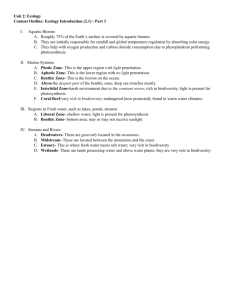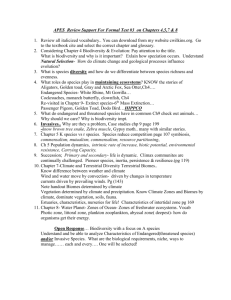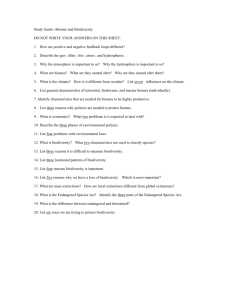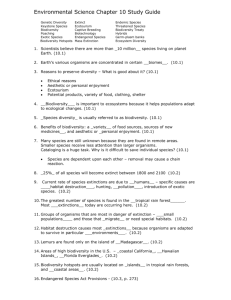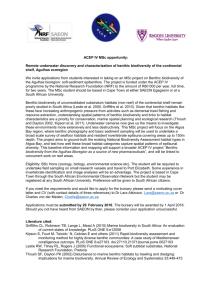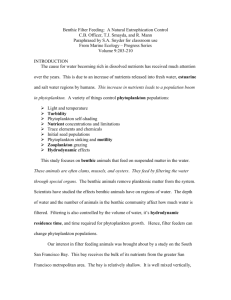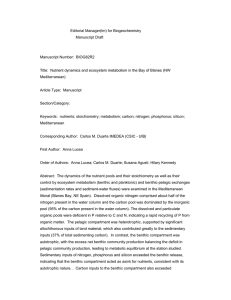Water and Aquatic Biomes Outline
advertisement
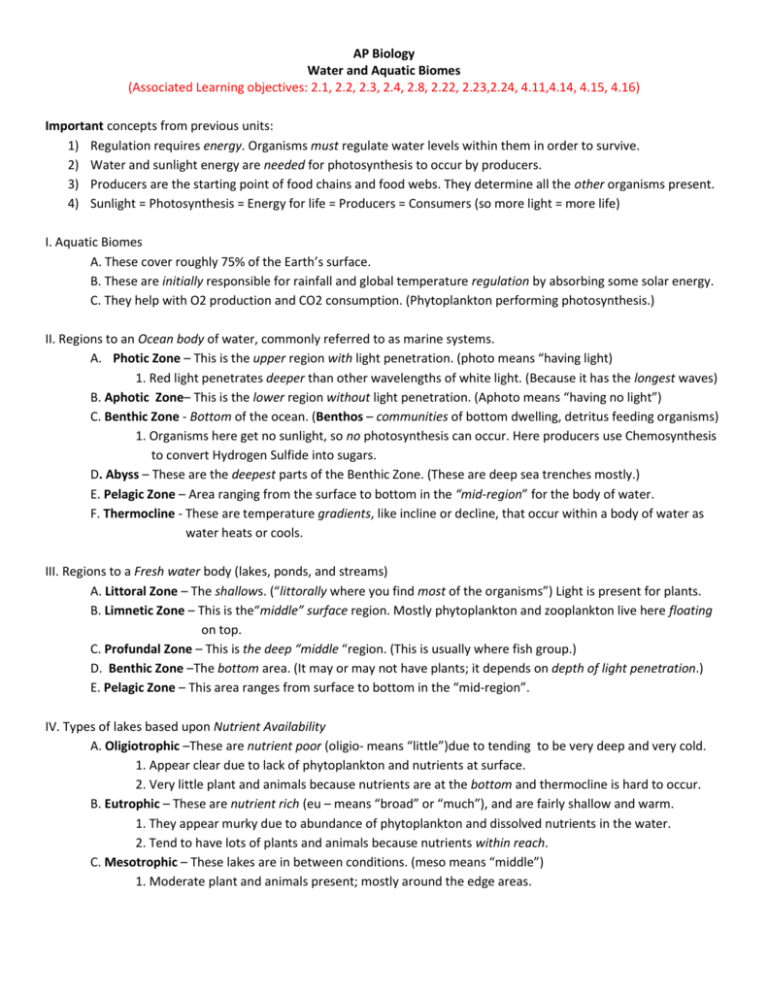
AP Biology Water and Aquatic Biomes (Associated Learning objectives: 2.1, 2.2, 2.3, 2.4, 2.8, 2.22, 2.23,2.24, 4.11,4.14, 4.15, 4.16) Important concepts from previous units: 1) Regulation requires energy. Organisms must regulate water levels within them in order to survive. 2) Water and sunlight energy are needed for photosynthesis to occur by producers. 3) Producers are the starting point of food chains and food webs. They determine all the other organisms present. 4) Sunlight = Photosynthesis = Energy for life = Producers = Consumers (so more light = more life) I. Aquatic Biomes A. These cover roughly 75% of the Earth’s surface. B. These are initially responsible for rainfall and global temperature regulation by absorbing some solar energy. C. They help with O2 production and CO2 consumption. (Phytoplankton performing photosynthesis.) II. Regions to an Ocean body of water, commonly referred to as marine systems. A. Photic Zone – This is the upper region with light penetration. (photo means “having light) 1. Red light penetrates deeper than other wavelengths of white light. (Because it has the longest waves) B. Aphotic Zone– This is the lower region without light penetration. (Aphoto means “having no light”) C. Benthic Zone - Bottom of the ocean. (Benthos – communities of bottom dwelling, detritus feeding organisms) 1. Organisms here get no sunlight, so no photosynthesis can occur. Here producers use Chemosynthesis to convert Hydrogen Sulfide into sugars. D. Abyss – These are the deepest parts of the Benthic Zone. (These are deep sea trenches mostly.) E. Pelagic Zone – Area ranging from the surface to bottom in the “mid-region” for the body of water. F. Thermocline - These are temperature gradients, like incline or decline, that occur within a body of water as water heats or cools. III. Regions to a Fresh water body (lakes, ponds, and streams) A. Littoral Zone – The shallows. (“littorally where you find most of the organisms”) Light is present for plants. B. Limnetic Zone – This is the“middle” surface region. Mostly phytoplankton and zooplankton live here floating on top. C. Profundal Zone – This is the deep “middle “region. (This is usually where fish group.) D. Benthic Zone –The bottom area. (It may or may not have plants; it depends on depth of light penetration.) E. Pelagic Zone – This area ranges from surface to bottom in the “mid-region”. IV. Types of lakes based upon Nutrient Availability A. Oligiotrophic –These are nutrient poor (oligio- means “little”)due to tending to be very deep and very cold. 1. Appear clear due to lack of phytoplankton and nutrients at surface. 2. Very little plant and animals because nutrients are at the bottom and thermocline is hard to occur. B. Eutrophic – These are nutrient rich (eu – means “broad” or “much”), and are fairly shallow and warm. 1. They appear murky due to abundance of phytoplankton and dissolved nutrients in the water. 2. Tend to have lots of plants and animals because nutrients within reach. C. Mesotrophic – These lakes are in between conditions. (meso means “middle”) 1. Moderate plant and animals present; mostly around the edge areas. V. Streams and Rivers A. Headwaters – These located in the mountains 1. Waters are cold, clear, fast, narrow, nutrient poor, high dissolved O2 so this affects the animals and plants found here – high oxygen demand organisms such as trout. B. Midstream – These are located in between mountains and coast. 1. Waters are warm, slow, wide, nutrient rich and murky due to erosion, lower dissolved O2. Plants and animals are moderate oxygen demanding such as bas s or catfish. C. Estuary – This is where fresh water meets salt water. (Such as the Bay of Mobile) 1. Very nutrient rich because of all the dissolved materials from upstream; water appears almost black. 2. Very rich in biodiversity -amount and types of life forms. (Almost as rich as a rainforest or coral reef.) D. Wetlands – These are lands possessing water and above water plants. 1. Two types exist –swamp (define by having trees) and marsh (defined by having reed grasses only) 2. They are very rich in biodiversity. 3. These areas are protected by law and are Gamelands and wildlife refuges. 3. These help to reduce flooding by holding rainwaters or hurricane waters. (VERY IMPORTANT) VI. Marine Biomes A. Intertidal Zone – This is a very harsh environment due to tides crashing and receding .It is rich in biodiversity due to the presence of light for photosynthesis. B. Neritic Zone – This runs from shore to the continental shelf drop off. It is very rich in biodiversity due to light. C. Oceanic Pelagic – Contains the photic and aphotic and lacks biodiversity; it is mostly big fish and mammals and plankton on the surface. D. Coral Reef – These are very rich in biodiversity. - Called the rainforests of the oceans. - They are endangered and therefore protected by laws. - They are found in warm water climates. E. Benthic – Moderate in biodiversity. (Mostly around deep sea thermal vents and mid ocean rift valleys.)

